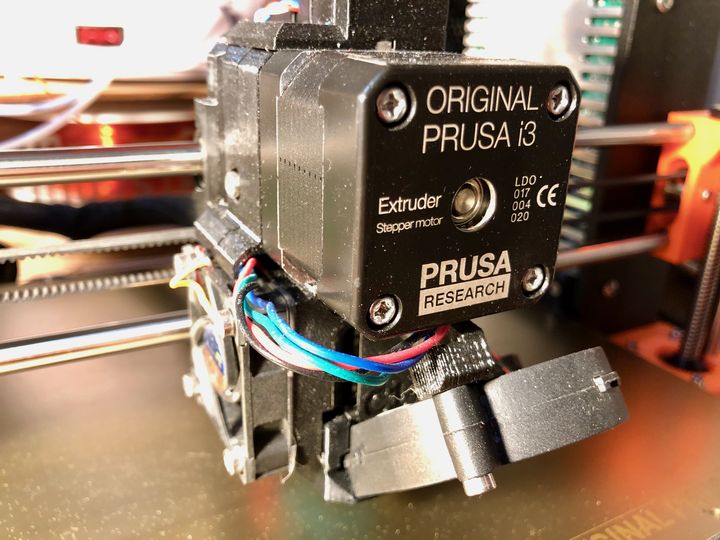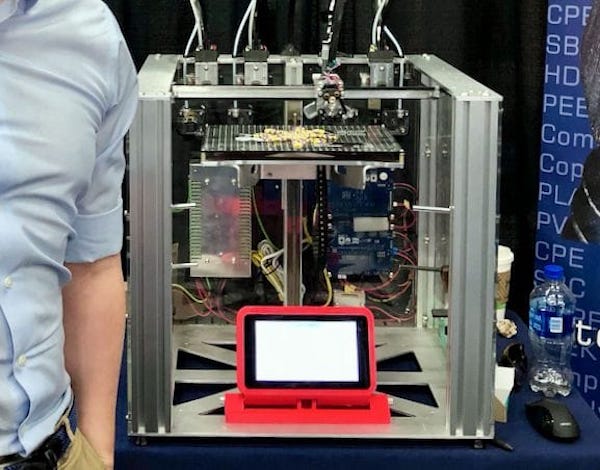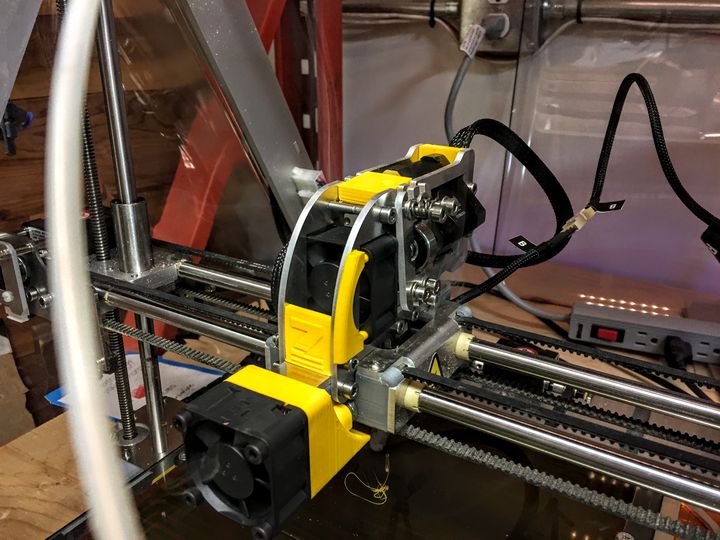
It’s easy to miss, but apparently Prusa Research is to develop a new 3D printer equipped with a “tool changer”.
It’s not entirely clear what is being developed, and there are several possibilities, including dynamic multi-material capabilities. Let’s review them and see what is likely going down here.
Multi-Material Tool Changer
A tool changer is one of several means to achieve multi-material 3D printing. The first attempts at multi-material involved simply strapping two hot ends to the toolhead, but that proved problematic for a variety of reasons. The next popular approach was to use a single nozzle and push different filaments through it. That worked better, but still had the problem of purging waste material during swaps.
Then came tool changing. This is a concept found first in CNC machining, where different milling bits would be highly desirable in long jobs: cut first very rapidly with a coarse bit, then mechanically swap in a fine bit for slowly finishing the surface. This concept worked very well and is now found in many milling devices.

A few years ago the fine folks from E3D-Online design and built a tool-changing 3D printer, which is one of the first to hit the market, with others from a very few companies such as Stacker and Mass Portal. The E3D device has one toolhead, but four hot ends. While one hot end is active for printing on the toolhead, the remaining hot ends remain “garaged” at the back. The unused hot ends stay warm so they can be used immediately, and if they drip it won’t be on the print in progress.
It’s a very functional solution, albeit involving a lot of mechanical movement. However, the E3D machine works pretty well from what I hear.
Prusa Research’s foray into multi-material 3D printing has been thus far only with their MMU attachment, currently at level MMU2S. This optional device straps on top of either a MK2 or MK3 3D printer and manages swapping incoming filaments. When a color material change is required, the MMU pulls out the active filament and pushes in the new one. But, like all single nozzle multi-material solutions, it suffers from the need for massive amounts of purged material to clean out the old color before new can be extruded.
But then in Josef Prusa’s latest blog post announcing the new MK3S+ and MINI+ devices, which we discussed the other day, there was a very intriguing line at the very end of the post. Prusa says:
“We are working hard so we can share news about our upcoming machines soon. In the meantime, I hope you will enjoy using not only the new sheets but also the MK3S+ and MINI+. And BTW – because we have more time to work on the XL, we decided to add tool changing to it 😉”
Whoa, this is a big development.
But first, to refresh your memory, the aforementioned “XL” machine is something Prusa Research has been quietly talking about for months now. It seems to be a “stretch” version of the flagship MK3S 3D printer that would offer a taller and wider build volume for larger 3D prints, rumored to be 400 x 400 x 400 mm. That’s a move many 3D printer manufacturers make, so it’s not totally unexpected.
We have no specifications for the XL device at this point, but from all previous indications it would simply be a MK3S with an extended frame. But now there seems to be tool changing involved as well.
This is very curious, as Prusa Research’s current and only method of achieving multi-materials has been through filament swapping with the MMU. Tool changing, if that is what Prusa refers to, is a technique they’ve not used before.
If Prusa Research indeed is to implement a tool changing mechanism similar to E3D’s, then some fundamental differences must appear on the XL’s toolhead and frame.
The XL toolhead would be modified to become a receptacle for portable hot ends, perhaps with a magnetic attachment mechanism to align the parts.
The rear of the frame would have to be modified somehow to accommodate the presence of several non-active hot ends. Depending on how they are placed, this could impinge on the Y-axis build volume. If that’s the case, then the frame would have to be extended in the Y-axis direction to maintain the same X-Y build area.
Laser, Scanner, Milling Tool Changer

But Prusa may be saying something completely different. Another use of the term “tool changer” in 3D printing has been to refer to the ability to change toolheads. This has been done by others to allow a hot end to be swapped out for a completely different tool.
Some machines allow the 3D printing hot end to pop out and be replaced by, say, a laser. This transforms the machine into a laser engraver. Sometimes the laser is double-used for 3D scanning use. Another commonly done tool swap is to add a milling toolhead that can perform subtractive operations.
Subtractive operations in this way are problematic because they, by definition, spray many small bits around the build chamber. This would normally foul up a 3D printer, and thus machines of this type require solid designs to ensure they can withstand the mess.
While building a swappable toolhead of this type is something conceivable, there is another huge issue: software.
To drive such a machine Prusa Research would have to somehow adapt PrusaSlicer (or make new software) to account for multiple new making processes, each of which has its own quirks and procedures. Making something like that is challenging enough, but it is even more challenging to design this software in such a way that users would find it easy to use.
3D Print Head Swapping
A final possibility for a “tool changer XL” machine would be to allow for quick manual swaps of a single hot end in the build chamber.
Why would you want to do this?
There’s one important reason: optimal extrusion for all materials is not really possible with a single hot end. Higher-temperature materials and flexible materials in particular pose problems for standard, one-size-fits-all hot ends.
It is for this reason you’ll find machines dedicated to particular classes of materials. You’ll see “all metal” toolheads or others suited for low-temperature flexible materials. One machine we have in the workshop here is the KODAK Portrait, which has dual hot ends: one is all metal for higher-temperature materials and the other is for PLA, PVA and flexible materials.
Could it be that Prusa Research would design the XL with a quick-swap hot end in which you could rapidly activate a hot end optimized for flexible materials? And then again for higher-temperature nylons? I could imagine a small selection of highly-optimized toolheads for a variety of exotic materials.
Such a device would require essentially no major frame alterations or even many software changes. It would only require re-designing the toolhead and hot end, and that seems achievable.
Prusa XL Prediction
After all this, what do I think will happen?
I believe Prusa Research will implement the last of my options, a manual, quick-swap hot end. It’s the easiest to design and implement, and would provide a lot of benefit for the effort. The other options are far more challenging to produce and just don’t seem like options Prusa Research would pursue.
What do you think?
Via Prusa
